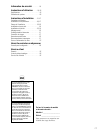
11
www.GEAppliances.com
Flush Procedure
Whenever water of unknown quality is passed through the GE Water Filtration
system, filter elements should be discarded and the filtration system flushed.
Circumstances that may require flushing the system are:
■ Boil-water advisory.
■ Flooding of the GE Water Filtration system.
■ Long-term non-use.
The procedure for flushing the GE Water Filtration system is:
See Filter Cartridge Replacement section and follow steps 1, 2, 3 and 4.
Next, reinstall the sumps (without the filter elements), turn water on and
flush water through the faucet for one minute.
Then, turn water off, remove sumps, empty water out of sumps and install
new filter elements.
Follow steps 5–11 in the Filter Cartridge Replacement section to complete.
4
3
2
1
Turn on the filtered water faucet. Then, slowly open the water
supply/saddle valve and allow the filter housing to fill.
Close the filtered water faucet. Then, check for leaks between the sump
and the head.
NOTE: If leaking, turn off the water supply and turn on the filtered
water
faucet. Disassemble the filter housing and check the o-ring for cuts, flat
spots, etc., and sealing surfaces for foreign material. Clean the o-ring and
lightly lubricate with clean silicone grease. Carefully press into the groove
in the sump. Reassemble and check for leaks.
If you are replacing the batteries, remove, properly discard and install
two new AA alkaline batteries in the battery pack. Removing the batteries
or momentarily disconnecting the lead wires resets the six-month
electronic timer. It is recommended that you change your batteries at
least once a year.
The filter cartridges contain activated carbon. When new, turn on the
filtered water faucet for ten minutes to flush the system.
Place filter change label on sump, inside cabinet door, or in another
convenient location. Write in date of filter change for future reference.
Filters should be changed every six months.
14
13
12
11
10


















